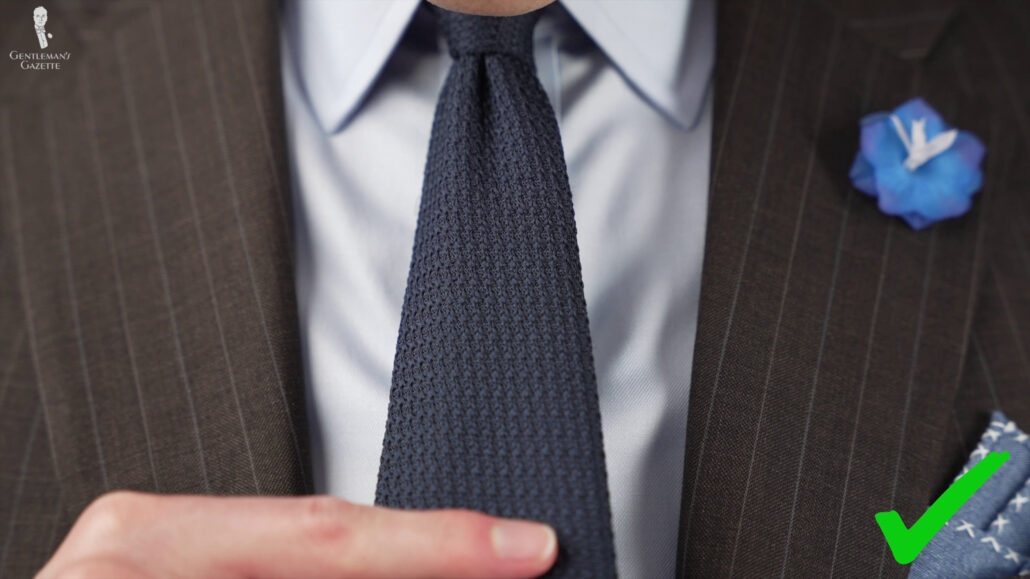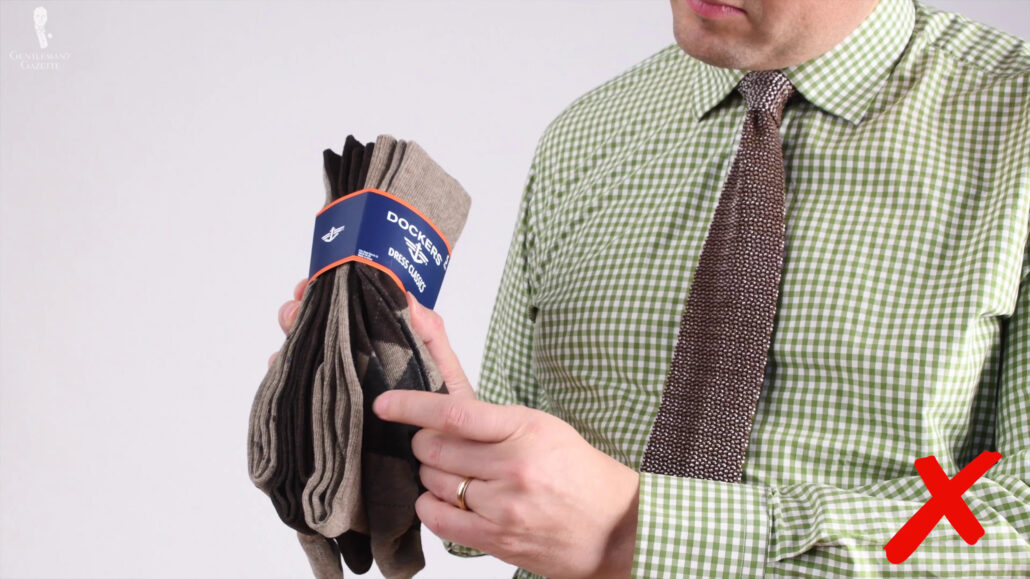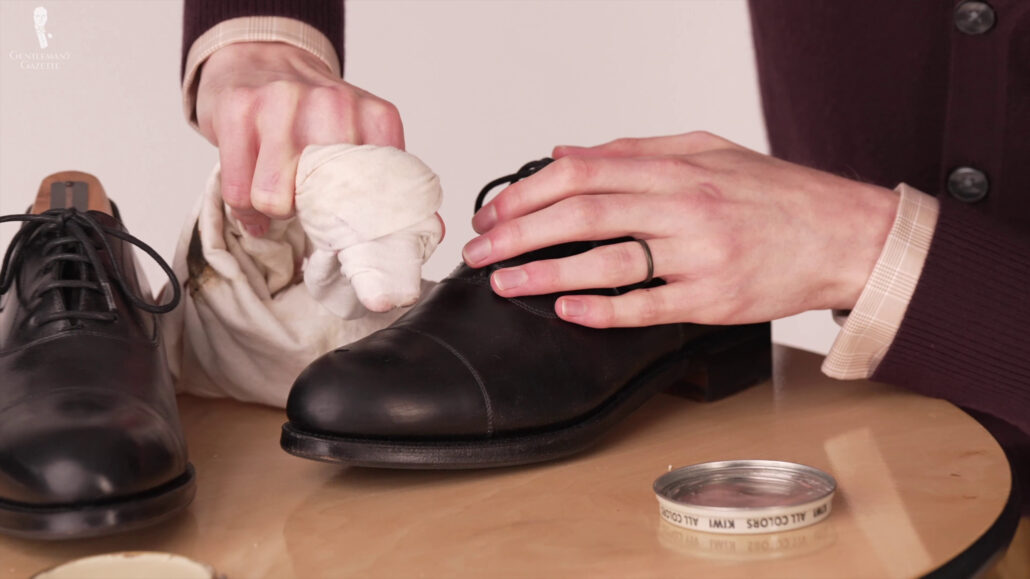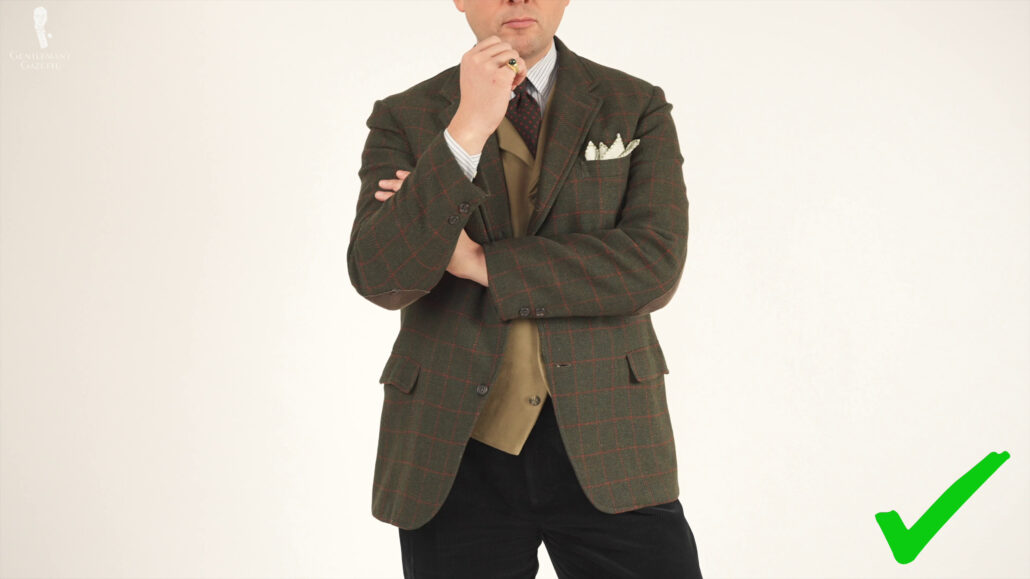Once you are firmly situated within the realm of classic menswear, you’ll start to develop a sixth sense of the principles behind it, which can be a blessing, as you’ll soon be able to develop stylish and cohesive outfits that also go well with your personal style. But, it can also be a curse as you are more likely to notice when something just looks off about other people’s outfits. Today, we’ll discuss things that menswear experts are likely to judge you for – silently, we hope – and how you can fix them.
Of course, our goal here at the Gentleman’s Gazette is always to be encouraging, not judgmental. After all, everyone has to start somewhere on their menswear journey, and in today’s dressed-down world, even putting forth the effort to look good at all is commendable.

But with that said, there’s no denying that some choices are just harder to look past than others. And while it is, of course, rude to say anything out in public, your typical menswear expert probably won’t be able to avoid twitching an eye a bit at these ten menswear mistakes. The good news is that all ten of them have relatively easy fixes that will take your future outfits from ordinary to extraordinary.
Before we begin today, though, we have already prepared many other guides covering the nuances of different dress codes, common menswear mistakes, how-to’s for attaining excellent fit, and the skills of wearing certain more niche articles of clothing. And while these guides make for the perfect style foundation, today’s guide is going to pinpoint issues that you’re likely to see on an almost daily basis. After all, the devil is in the details, especially for clothing enthusiasts.
Mistakes Experts Will Judge You For: 1. Polyester Satin Ties

Few articles of clothing conjure up memories of high school proms or first job interviews quite like the poly-satin tie. These ties are inexpensive to get hold of, and they can seem like a good attention grabber to the untrained eye. However, these ties actually grab attention for all of the wrong reasons.
While they are bold, they are overly shiny nature can be distracting and their synthetic materials mean that they just don’t hold a knot very well. Not to mention, they’re likely to break down and bend out of shape over time, meaning they’ll look even worse, especially if they’re a poly-satin zipper tie.
They’re also commonly associated with those who only begrudgingly wear suits and ties if necessary. However, this generally means that they have the paradoxical effect of sticking out like a sore thumb even when the wearer wants to remain unseen. The remedy is to invest in quality ties made from natural materials.


Neckwear like this has a much more organic texture that can be alternately subtle or attention-grabbing depending on how you assemble the outfit around it. Plus, they’re never going to look cheap. They’re also going to hold up better over time and blend more organically with a wider array of outfits meaning that it should be easy for you to assemble an essential tie rotation. And if you are wondering where to look for ties like these, we think the Fort Belvedere shop is a great starting point. But there are plenty of other great examples out there as well, and you can learn what the hallmarks of a quality tie are here.
2. Tiny Shirt Collars


As broader style trends are just starting to transition out of this super slim and skinny fit era, finally, we can now look back on some of the style trends that were all about making things as small as possible. And perhaps one of the worst offenders in this camp are anemic shirt collars.
These are often, though not always, configured in a casual button-down style and they’re really not meant to be worn with a tie as you’d have to jam one in there pretty tightly. Simply put though, these collars don’t frame your face very well and might even have some people asking if you were shopping in the boys department by accident.
The solution to this problem then is finding a collar shape that does suit your face well. Everyone has a subtly different face shape so it’s important to find a collar style that’s going to harmonize well with your own facial features. So, to discover what style will work best for you, you can take tips from our guide.
Shirt Collar Styles for Men: The Complete Guide
3. Sloppy Socks

Socks can often be the most overlooked part of an outfit as they’re generally only seen situationally even in classic style. Unless that is you’re a firm advocate of Plus Force. However, nothing ruins a polished look quite like slippery socks.
While the lackluster material quality in cheaper pairs of socks is the chief reason why socks are going to slide down, it isn’t the only reason this happens. Even higher-end socks are going to slide down over time if they’re too short.

The solution to this issue then is traditionally styled over the calf socks. This style was the default choice for men during the Golden Age of Menswear and is easily the most functional. This is because over-the-calf socks, at least when they’re properly elasticated, conform better to the muscles of your lower leg and will be less prone to have gravity pull them down over the course of the day. These types of socks are also readily available in the Fort Belvedere shop but rest assured that you can find them from other manufacturers as well.
4. Tired Knitwear

Part of the appeal of knitwear is that it’s softer and more casual than most other tailored items. However, the line between casual cool and frumpy can be a thin one.
The biggest downside to knitwear, then is that over time, it can wear down aggressively. This will lead to a garment that is saggy, threadbare, pilling, and generally unappealing. And it won’t matter how expensive the knitwear was either, as even high-quality cashmere can’t outperform poor maintenance habits.
How do you fix this problem, then? Simply by taking care of your knitwear because it is more fragile than sturdier fabrics, it will require more upkeep to ensure it stays looking great. So whether that means hand washing using specialty washing bags in the machine, carefully removing pilling, or storing it properly during the seasons you’re not wearing it, the key to sweater maintenance is proactivity. This then should keep you looking more Steve McQueen cool and less Simpson’s cat lady.
5. Creased Shirts

Most of us probably realize that dress shirts are going to look unsightly if they haven’t been properly ironed. But alongside wrinkles from rough wearing, this same ill effect is shared by brand new shirts out of the package that still has those packaging creases intact.
We know it’s exciting to get a new shirt to wear, and sometimes you might get impatient to wash it before wearing it for the first time. And I think we might all secretly want to emulate the cool air of Don Draper keeping a few fresh white shirts in his desk drawer. But this practice, in general, is a bad habit that will be noticeable to anyone with an eye for detail.
These creases are going to be most prevalent on the cuffs collar and main body of the shirt and probably aren’t going to resolve themselves as the day goes on, and nobody really wants to look like origami. This should go without saying, of course, but aside from those packaging creases, regular wrinkles in your shirts aren’t going to look great, either.

The best way to remedy this is to simply by ironing your shirts. Becoming skilled with an iron is something that takes a bit of practice, but our guide on the subject should speed up that process for you exponentially.
How To Iron A Dress Shirt
6. Poorly Cared-For Shoes

Nothing breaks our hearts more here at Gentlemen’s Gazette than seeing a neglected pair of shoes. Shoes are truly an investment piece that set the literal foundation for your wardrobe. And even a smart-looking pair will be greatly cheapened if they aren’t properly maintained. And aside from the obvious concerns of the body of the shoe, this also includes tattered, mismatched, or even broken shoelaces as well.
As you might imagine then, the simplest way to fix this issue is by implementing a proper shoe care routine. And given that shoes are often going to be the most expensive part of your wardrobe, you definitely don’t want them falling apart prematurely.

While you certainly can go all out with your shoe care routine, it doesn’t have to be anything incredibly labor intensive either. Just a basic shine every couple of weeks and some edge dressing applied judiciously now and then will go a long way. And remember not to skimp on your shoelaces, either. Not only are they an extremely economical way to elevate the look of your shoes but they can also contribute greatly to your overall wardrobe versatility.
Overall then, we can’t stress enough how important it is to properly maintain your collection of shoes as they’re often what makes or breaks an outfit.

7. Low-Rise Pants

We understand that low-rise pants have been the defacto and dominant look in men’s style for quite a while now. But simply stated if you’re going for a more classic look, then they’re not the optimal choice.
In general, they’re not going to be flattering on most men either, as they’ll create the illusion that you have a long torso and unnaturally short legs. They can also create that ugly triangle of shirt fabric underneath your jacket button when things aren’t positioned correctly. And, of course, if you are carrying a few extra pounds around your midsection, this will only be exaggerated even more.

MEN DURING THE
Golden Age of Menswear
They mostly wore high-waisted pants to create a clean, uninterrupted transition in their looks.
The solution here, then, is to find a pair of well-fitting, high-waisted trousers. And while the last time this particular pant style was in vogue was the early 1990s or so, classic menswear fans might be in luck as they seem to be on the rise again lately. And, of course, they were the de facto choice for most men in the Golden Age of Menswear.
This is in part because high-waisted trousers hit around the natural waist of the body which dividing the body into portions hits upon the famous golden ratio. And while this has been a well-kept secret for decades now, high-waisted pants are probably going to be more comfortable for most men.

8. Too-Thin Fabrics
A suit with a tag saying that the wall is super 150s is certainly nice but if it drapes like a garbage bag, it’s still not a good option for you.

Modern fabrics focus heavily on having their composition be as lightweight and soft as possible as this contributes to a hand feel that is often associated with luxury. The problem is though, that these super thin fabrics don’t drape well on the body at all.
Heavier fabrics, meanwhile, will create more structure for the garment, meaning that it will drape attractively rather than pinching and pulling every which way on your frame. This effect is especially visible when comparing trousers where a heavier fabric will hang down from the waist creating a wonderfully clean line that flatters the leg while meanwhile thinner cloth is going to wrinkle and pucker all over, making it look as though your legs are covered in aluminum foil or parchment paper.

It’s also important to note here that fabric weight and breathability are often correlated but they’re not the same thing. In other words, not all breathable fabrics are going to be lightweight, and not all lightweight fabrics are going to be breathable.
As some examples here, plenty of heavy linens are going to both drape and breathe extremely well. And wool is on a spectrum where it’s easy to find heavy weighty tweeds that are going to keep you warm and also crisp thinner frescos that will cool you down easily. So, it’s entirely possible to wear something that will meet the demands of the day’s temperature while also flattering your figure. And a little bit of knowledge about which fibers are best for certain tasks goes a long way here.

So don’t just trust the fabric label or even the salesperson as what feels good in the hand might not necessarily look good on your body. Practice makes perfect.
9. Dull-Solid Colors

We’ll put things simply for this item on the list. For goodness sake, add some more color and pattern to your outfits. Many stores these days offer a huge amount of clothing, but unfortunately, they often seem to be stuck in the same sea of sameness, with the most common offender here being plain black clothing. After all, while Johnny certainly Cash-ed in on the all-black look, you don’t also have to make it your own crutch color.
Even setting aside black for a moment, many retailers are also offering dull, uninspired, and flat shades of gray and blue that aren’t going to do you any favors either. Instead, just trying to add a greater variety of color and pattern into your wardrobe. After all, one of the hallmarks of classic menswear is the ability to play with the nuances of pattern and texture.

So even if you do prefer solid colors in your looks, textures are still going to give you a unique edge that will differentiate from the dull flat styles that many retailers offer today.
10. Wearing Outerwear That Doesn’t Match
Outerwear can be the key to creating some incredibly refined menswear looks. But topping off an outfit can become a Frankenstein experiment gone wrong when adding outerwear that hasn’t been properly coordinated with formality and seasonality in mind.

Some examples of this phenomenon would include things like waxed jackets or even puffer vests worn over a suit which create a clash of informal and formal garments. Or mismatches of seasonality like pairing a thick overcoat with a linen suit wearing a straw hat in the middle of winter or a felt hat in the hot days of summer.
Not only are all of these choices just going to make you look off, especially from a formality perspective, but they’re also going to make you cooler or warmer than necessary given the season.

The best way to prevent this problem is to implement the philosophy of Scorpacciata into your wardrobe. This will help you to break up your wardrobe into distinct seasons where the fabrics, patterns, colors, and textures are going to harmonize better with the conditions of your environment and will allow you to savor each slice of your wardrobe even more. And, of course, for those in between seasons, it doesn’t hurt to have a few transitional pieces too. As an example here, an overcoat might be overkill in fall or spring, but a trench coat might not be.
Scorpacciata: Savoring Seasonal Fashion Like Food
Conclusion
While learning the basics of dressing well can be simple, it’s mastering the nuances that will set you apart. While it does come more easily to some people than others, these issues are generally easily mitigated. It just takes some self-reflection and a good knowledge base to understand what you’re looking for and, like any other skill, practice. And as we’ve said many times before, we here at the Gentleman’s Gazette are here to help you at every step along your style journey.
For a bit of fun, if you’ve got any style pet peeves that you see others constantly committing, let us know in the comments below. But please keep things light.
Outfit Rundown
Today, I’m wearing a somewhat casual ensemble that works well for the warm weather that we are currently experiencing here in Minnesota in summer. The central element, of course, is my double-breasted sport coat in a light blue color with a subtle checked pattern and some texture in its weave.
The jacket is also made from a blend of linen, wool, and silk. I’m wearing it over a French cuffed shirt which features alternating stripes in white and light blue. I’ve chosen not to wear a tie today to go for a more summery feel, but in the French cuffs, I do have our gold-plated sterling silver eagle claw cufflinks from Fort Belvedere with blue lapis lazuli as the stone.
My trousers are plain khaki-colored, and while they are relatively lightweight, they do drape a bit better because I’ve got them situated on my natural waist using a pair of blue suspenders. My pocket square is a vintage model in light blue silk and featuring paisley patterns in blue and an orangish buff shade.
My boutonniere and socks are also from Fort Belvedere. The boutonniere is an Edelweiss that features tones of off-white and blue, and the socks are a relatively new addition to our Fort Belvedere shop in khaki and blue shadow stripes.
On my head is my trusty coconut straw pork pie hat, good for summer, and underneath, I’ve kept the casual feel going by leaving product out of my hair and letting my facial hair grow a bit.
On my feet, a repair of blue suede loafers from Henry Stevens, and to directly harmonize with these, the fragrance I’ve chosen today from the Roberto Ugalini fragrance collection is Blue Suede Shoes. And you can find all of the Fort Belvedere accessories I’m wearing today, including the socks, cufflinks, and boutonniere, along with a wide variety of other accessories and the Roberto Ugolini fragrance collection, by visiting the Fort Belvedere shop.













Hmm, High waist trousers do indeed look better. They may be hotter in the heat than lower-rise slacks, depending on the weave and fabric weight. The comfort is also in what temperature one is accustomed to.
Shorts should not be worn with jackets. Does one just need to adapt to the heat to look dapper or is there an another way?
Other things you’ll be judged silently on:
1) Wearing things at either extreme – I find it particularly disgusting seeing men wearing clothes, especially trousers, skin tight like leggings or yoga pants. They look uncomfortable wearing them like that, it throws off their proportions and let’s face it…certain things are better left to the imagination. Wearing things oversized also isn’t great as it looks like the clothing is wearing them and it can over emphasise someone being very slim like Preston and equally someone who is on the heavier side.
2) Trousers being too short – manpris are not a good look
3) Wearing white gym socks, especially little ankle ones, outside of gym/exercise wear. Especially when worn with dark dress trousers.
Actually, I thought you were wearing Cool Water by Davidoff.
My main style pet-peeve is probably just far-too-tight jackets. I prefer relatively fitted jackets—working for a mainstream menswear brand, I feel it’s a bit of an occupational hazard—but once X-wrinkling occurs, I can’t do it. Many a sale I’ve lost because I wouldn’t tell a customer to buy sartorial wallpaper. Similarly, no-show socks (or loafers as a concept) rub me the wrong way.
I agree with many of the points in this article and especially want to emphasize the importance of preparation. Clothing is a form of speech, and as such, judgement should be passed not on the sophistication of dress, but on the preparation and care taken with an ensemble. I have lived in many rural and impoverished areas and even there how someone dresses for an event speaks volumes about the importance they give for that event (wedding, graduation, celebration). In the rural areas, proper ironing and especially clean shoes show that someone spent the time preparing for the event because it was important. I bring those sentiments back in the US and choose not to judge on the quality of the clothes but on the quality of the sentiment used in the preparation.
A former professional leader, who was my superior, was fond of wearing braces and a belt with his suit trousers.
When I wore only braces, he commented.
After I suggested that he inquire regarding which look was correct, my boss subsequently wore either a belt or braces, and our relationship was never particularly collegial thereafter.
Best regards,
Andrew Gregg.
Palm Springs, CA.
Preston,
Well written article about Mistakes Experts Will Judge You For. One uestion – item #7 Low Rise Pants displays a pair of yellow wide wale corduroy pants. Exactly the ones I have been searching for years. Can you tell me who makes them? I would be eternally grateful if you would be kind enough to share it.
Good article, Preston but I have to judge you on your last picture. Your’re wearing an open collar shirt with your double breasted jacket. I’m surprised you didn’t realize that the shirt is drooping. This doesn’t look good! Either wear a necktie, or get a stiffer shirt placket so that it stands up out of your jacket lapels.
There is a current and annoying fashion trend which seems to be also happening with GGs presenters ….leaving the second shirt button undone. It draws attention away from the shirt to the wearers hairy (or otherwise) chest leaving the shirt as a secondary item. Not good.
Another “no no” is wearing a dress shirt without a tie and having a flaccid collar and placket.
Thank you for the note about shoes. My pet peeve when I see men about town is footwear in general. I live in a hot climate (Washington, DC) and I see men wear sandals or other open toed shoes all the time. It’s bad enough that I have to look at bare feet, but when you see knarled toenails, it’s enough to make me upchuck! I also see all sorts of socks being worn with something that barely covers the foot.
I don’t mind sneakers during the day, and I sometimes wear them myself, but I often see garish colors on oversized sneakers. They have a definite “look at my overpriced footwear” look, which I find silly.
Button your shirt up to the last button which should be unbutton. I do not like window pane in a different color then the jacket or trousers.